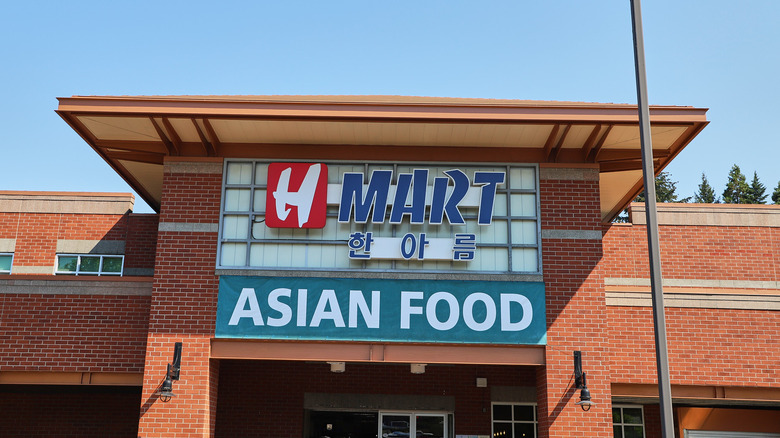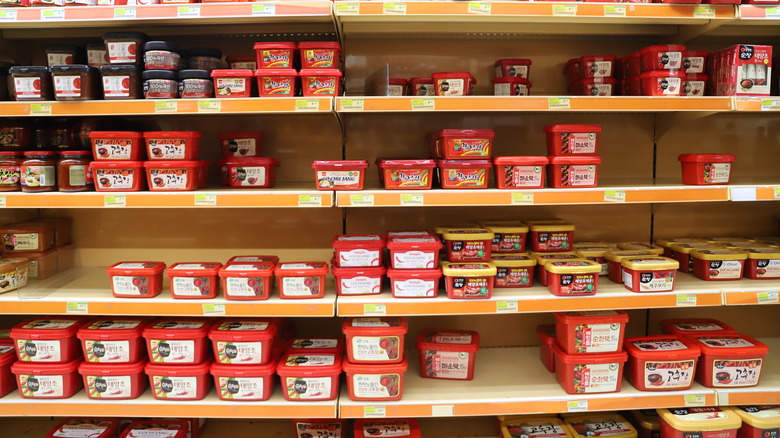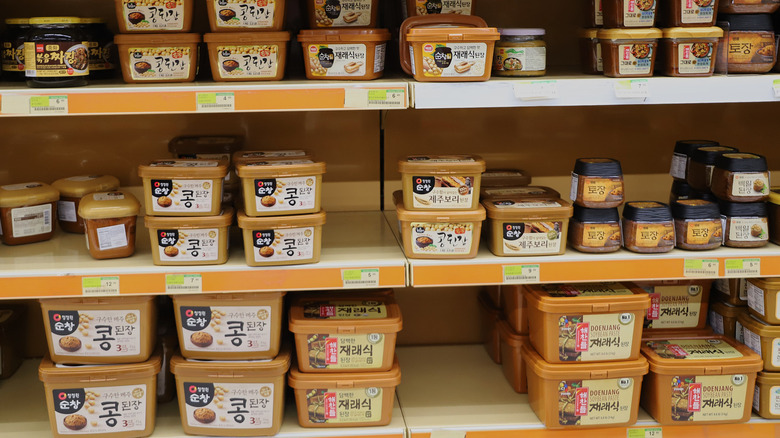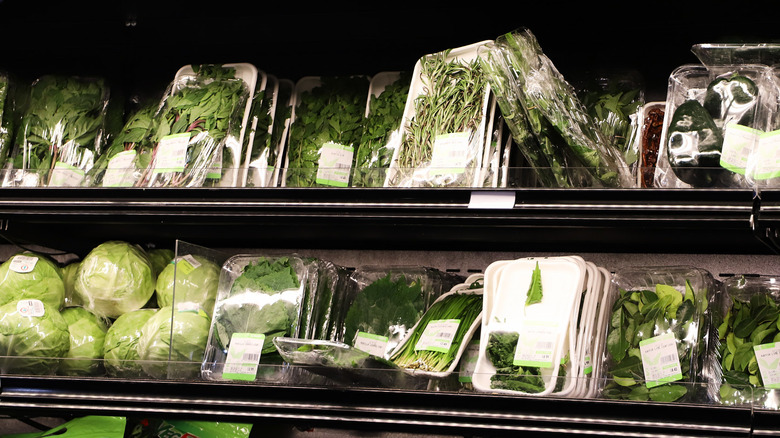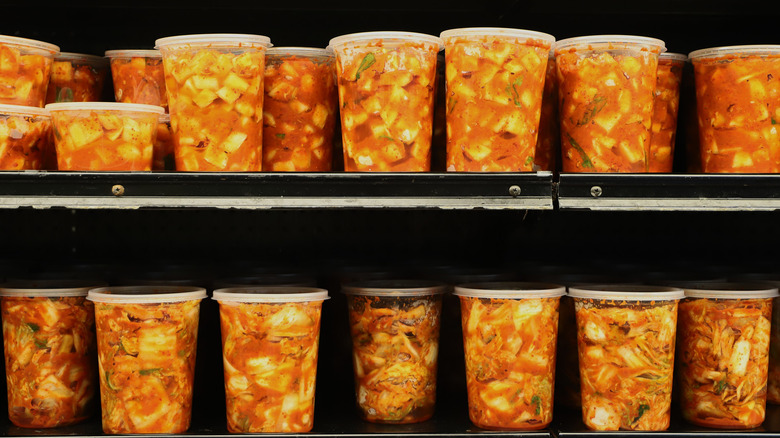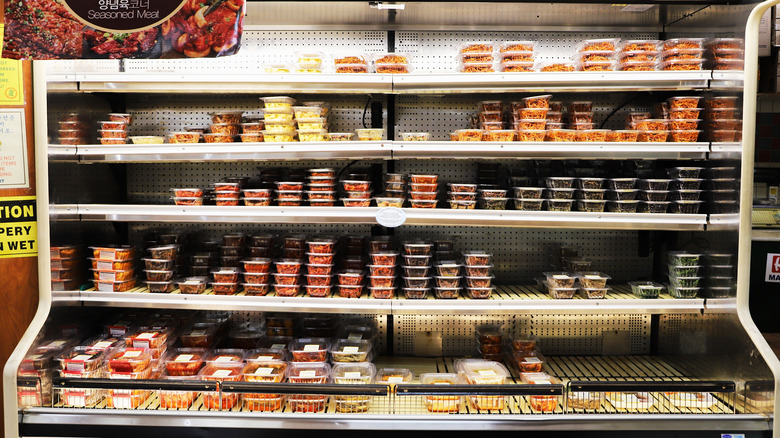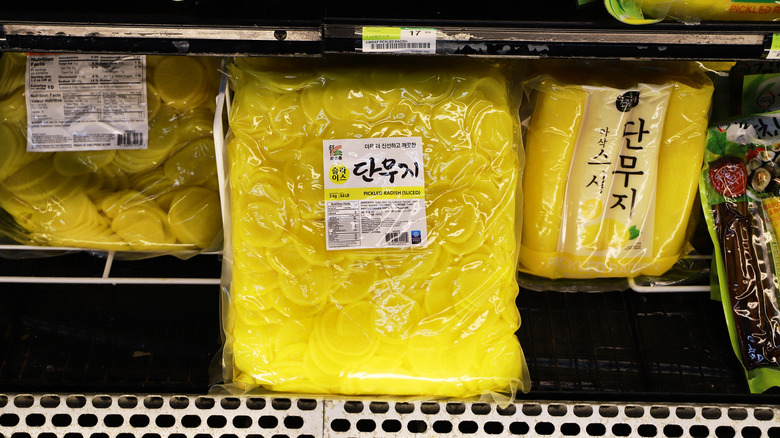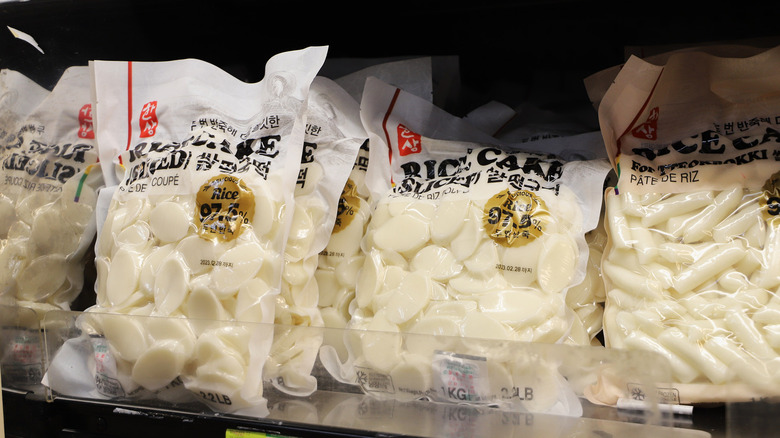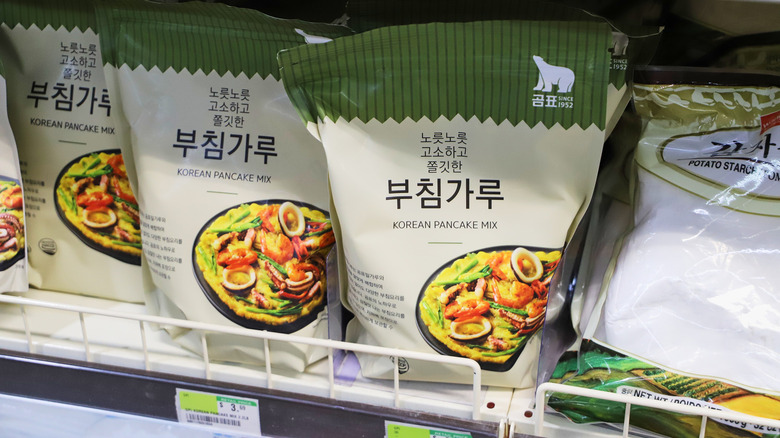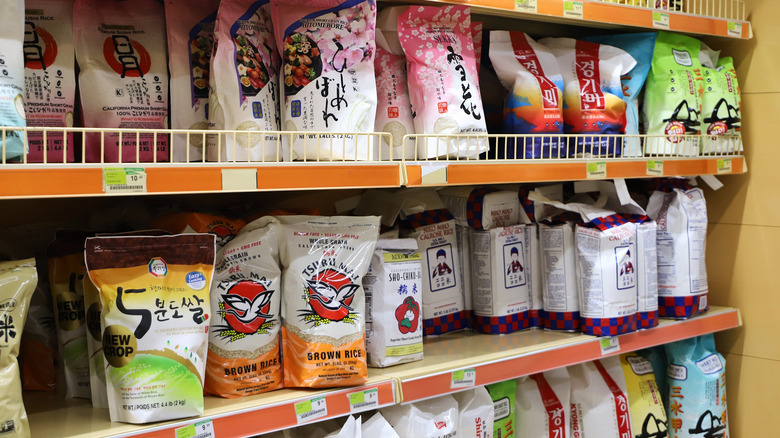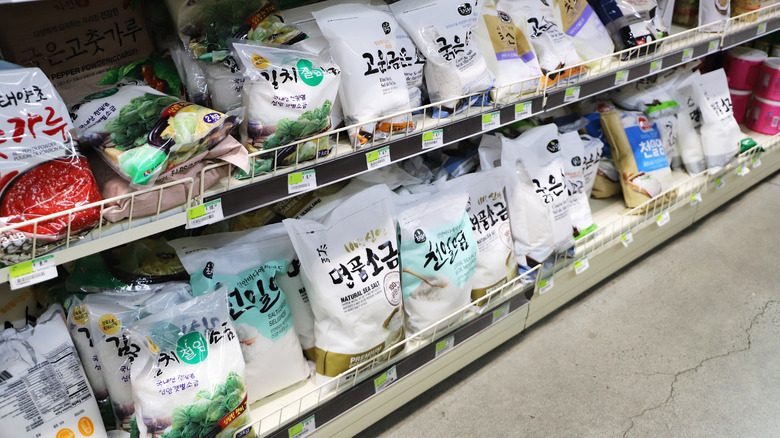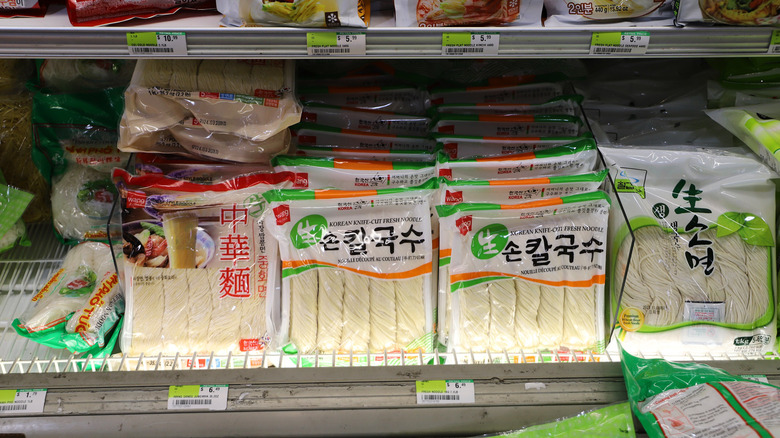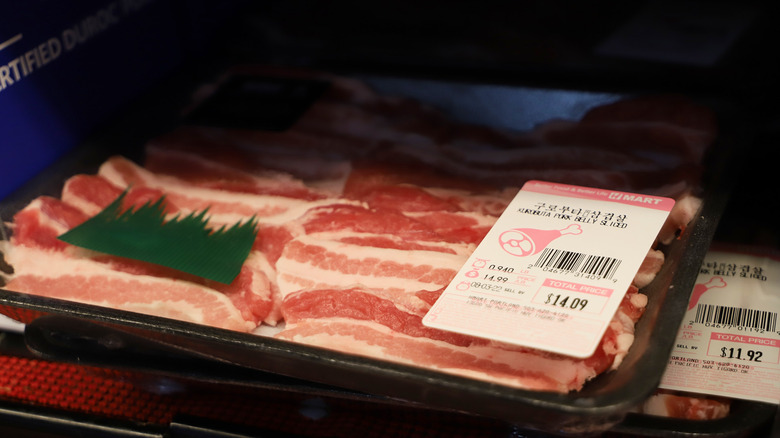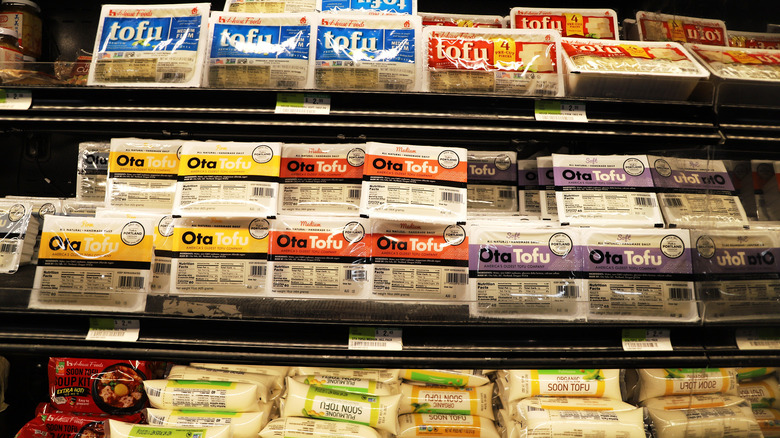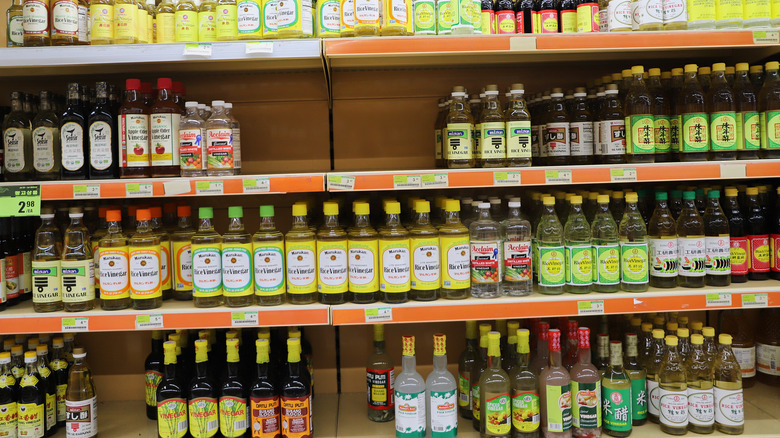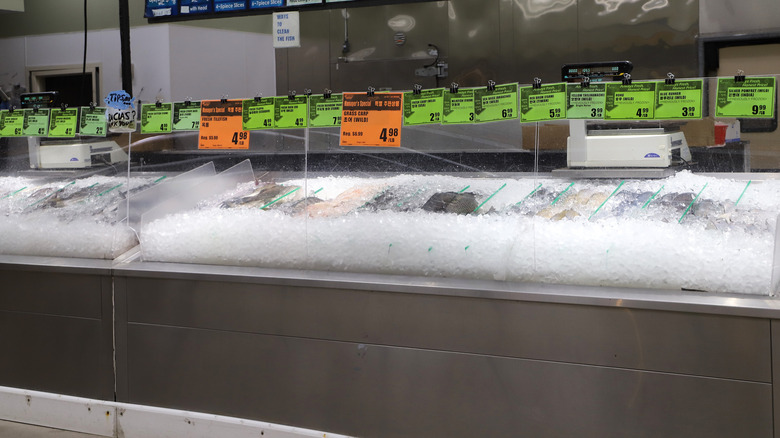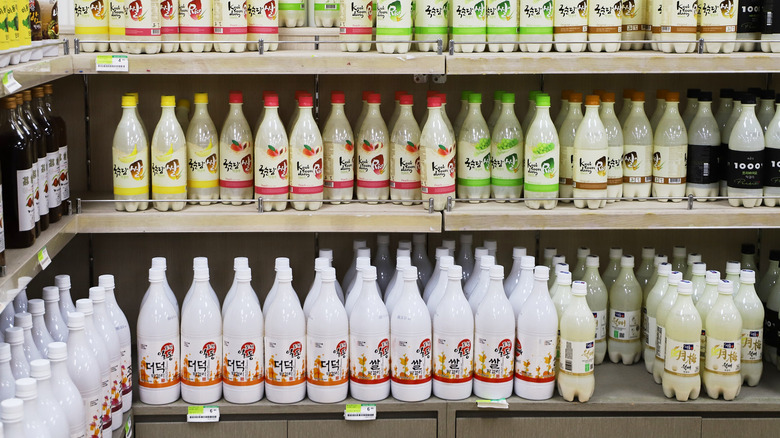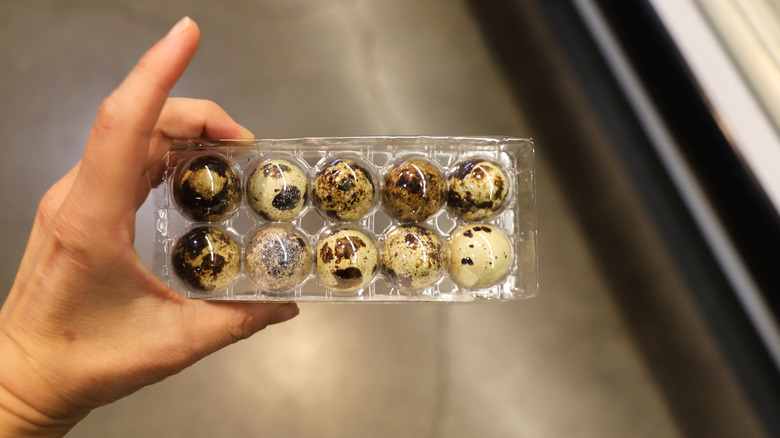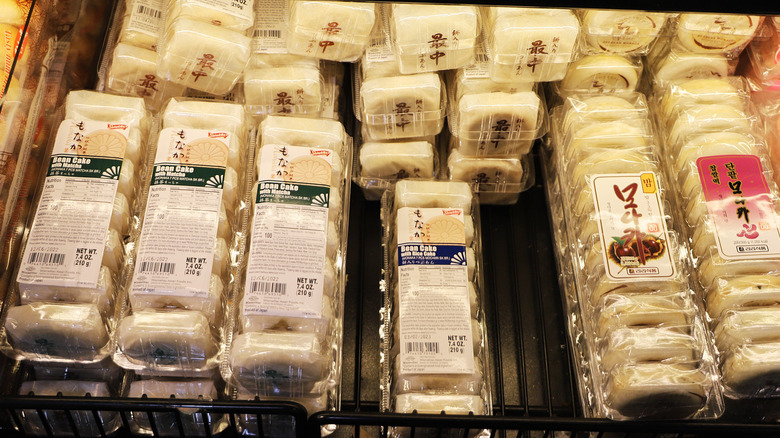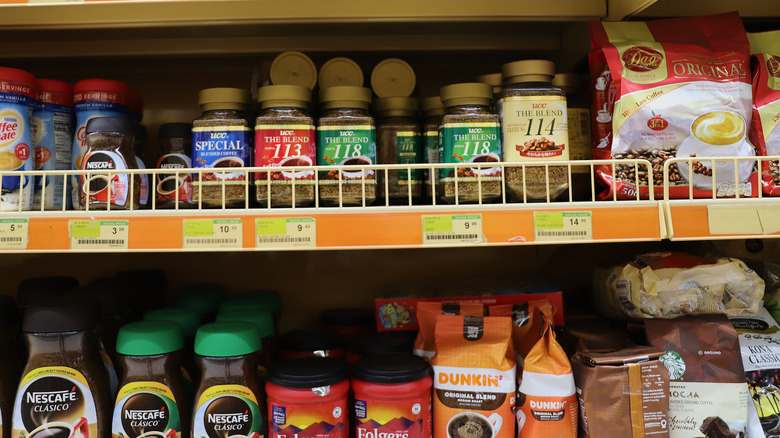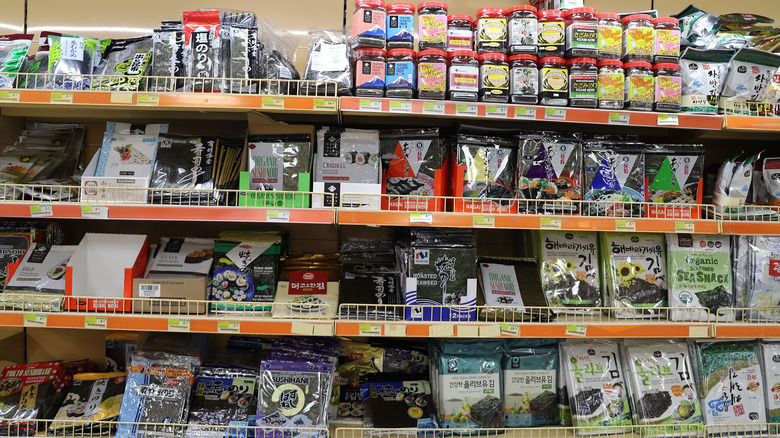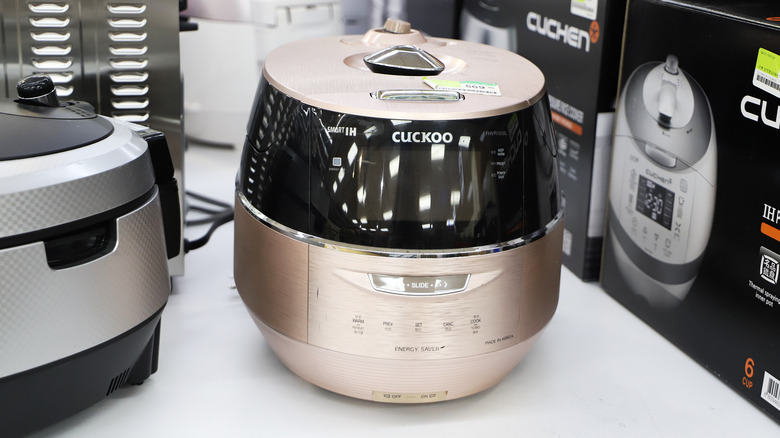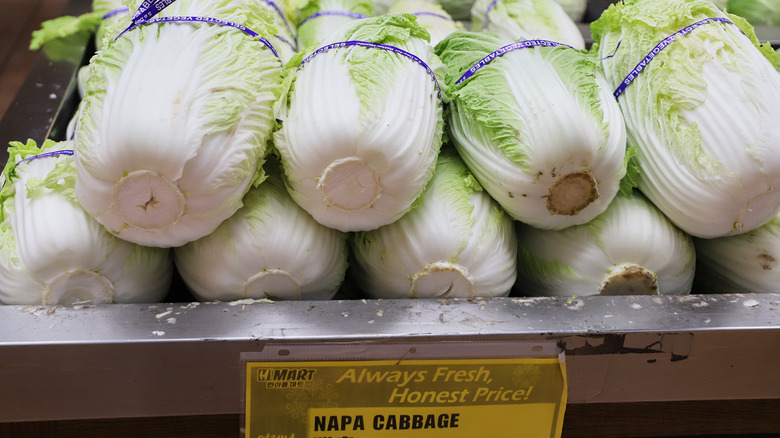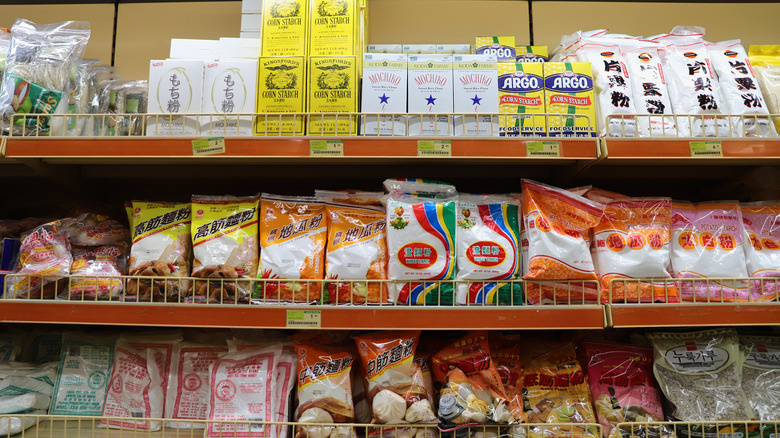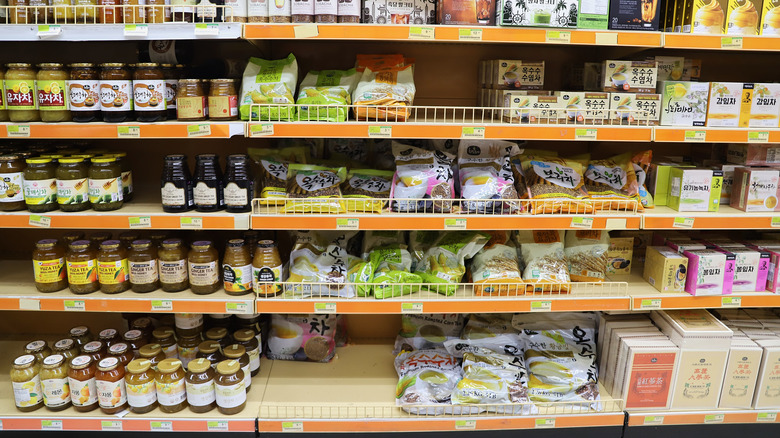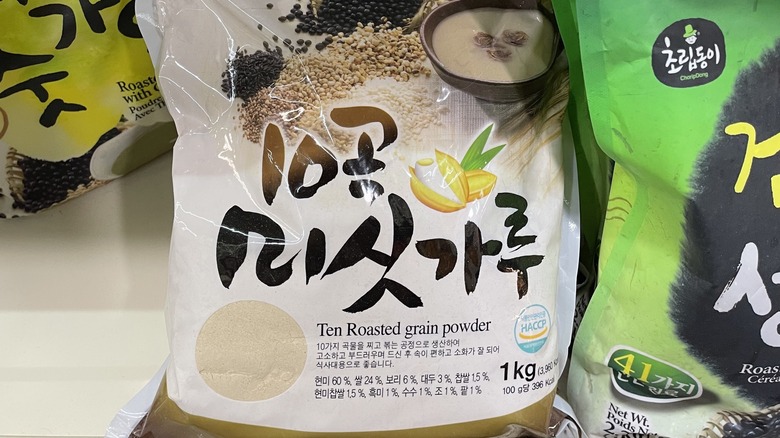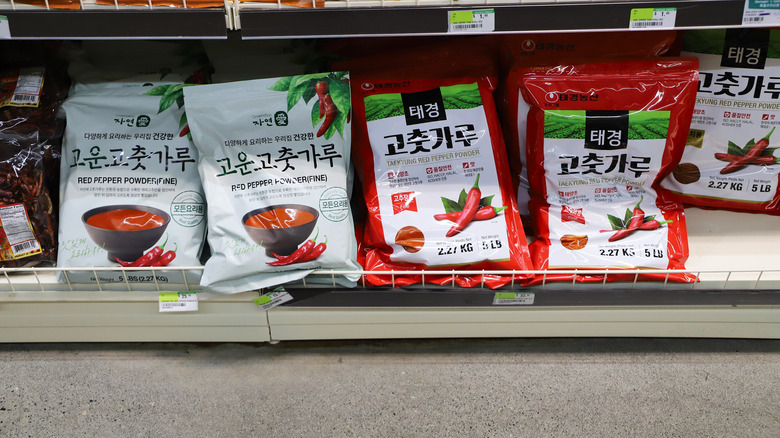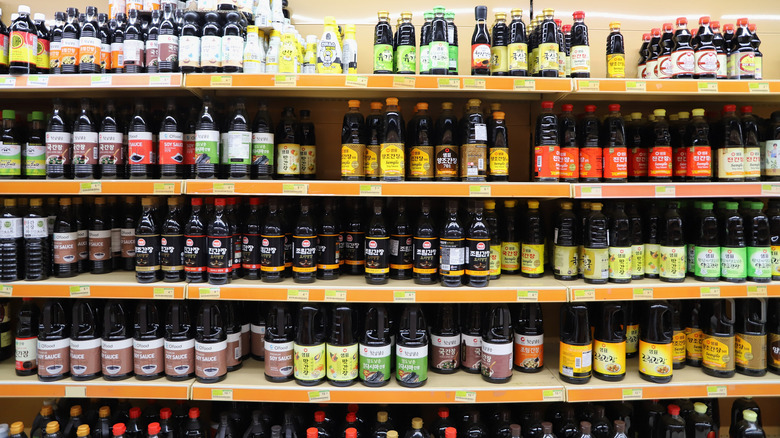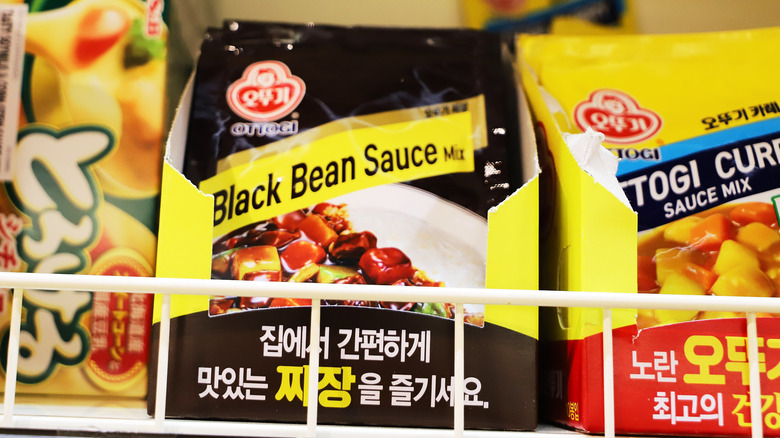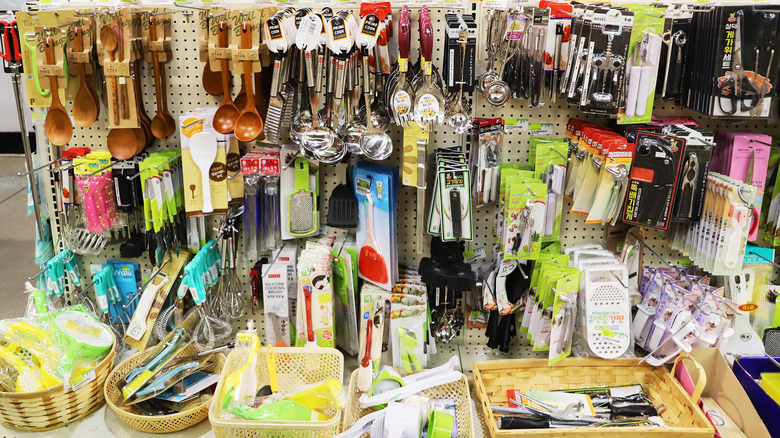30 Items At H Mart To Make Authentic Korean Meals
H Mart, the Korean-owned Asian grocery chain, changed the accessibility to Korean (and other Asian) goods in the U.S. But for many, their aisles remain a mystery to most. Korean food — known for its barbecued meats, sweet/salty interplay, and small plates — has burgeoned in many American cities and can be attempted by the home cook.
But what to stock in your newly-minted Korean pantry and fridge? We're here to help you untangle the essentials of the Korean kitchen and point you in the direction of our favorite Korean ingredients so you won't be left "Crying in H Mart," like our favorite musician turned memoirist, Michelle Zauner (also known as Japanese Breakfast).
Launched in 1982, H Mart has now grown to nearly 100 stores within the United States alone according to H Mart's latest count and can be found in most American cities or suburbs. But too often we've noticed our aisle neighbor's basket overflowing with (admittedly delicious) Korean snacks, candy, frozen dumplings, and instant noodles but sadly lacking any actual ingredients to make their own versions of Korean food from the comfort of home. Here, we're rounding up 30 Korean ingredients we always pick up at our local H Mart for your next trip to the Asian superstore. (Pro-tip: Bring a jacket since their stores are often chillier than American grocery stores.)
Gochujang
You'll typically find an economy-sized tub of gochujang front and center in most Korean refrigerators. It's a spicy paste made from the Korean pepper, gochugaru. The fermented condiment flavors banchans and main dishes throughout the country's cuisine. The tangy, slightly sweet sauce makes its way into dishes like kimchi fried rice and should ornament the center of every bibimbap bowl for the diner to stir into the sticky rice and vegetables. H Mart's shelves are always stocked with a disorienting amount of choices, but we suggest trusting your gut and tasting up and down the aisle until you find the tub of gochujang that fits into your kitchen's creations.
Doenjang paste
Right behind the vat of gochujang in most Korean refrigerators sits the amber-hued (but identically shaped) container of doenjang paste (or, Korea's answer to miso). Just like Japanese miso, Korea's doenjang is also made from fermented soybean paste and adds a super salty umami punch to savory dishes. Typically a little chunkier than Japanese miso, doenjang also omits any grains or koji starter and is made solely of salt and soybeans. While doenjang (like miso) is endlessly versatile, we love it as the backbone to our favorite accompaniment for galbi, ssamjang, or whisked into a simple, comforting soup with cabbage and tofu.
Perilla, curled scallions, and other herbs
Ever read a recipe and had to Google the exact type of herb and spice the author is asking for? If you come across a stumper in an Asian cookbook, there's a good chance H Mart will have the herb you're looking for. Traditional items like perilla (shiso in Japan) that can be featured in your ssam sets — along with pre-cut and curled scallions — are packaged and vacuum sealed at every H Mart we've ever been to and sit just above the fresh produce. H Mart also is a great resource for other herbs like lime leaves, chives, mint, and various species of basil you might encounter in an Asian kitchen.
Kimchi
Making kimchi from scratch is understandably intimidating and, when H Mart's shelves are consistently flush with big, red jars of kimchis in multiple variations, grabbing one to round out your Korean feast feels like the obvious choice. Perfect from breakfast to dinner, kimchi's presence on a Korean table is nearly as necessary as plates and chopsticks. We love their classic baechu kimchi, but if we're lucky enough to roll through an H Mart on a Sunday when the chain offers more pre-made items, we indulge in our favorite: ojingeo bokkum, or kimchi made from dried squid and gochujang.
Pre-made banchans
Banchan is often translated to "side dishes," according to Maachi.com. Kimchi, the banchan most non-Koreans are most familiar with, is amongst the most well-known banchan, but Korean kitchens contain countless amounts of other small, often vegetable-forward, dishes. Served alongside larger dinner items, banchans are meant for families to make and share with one another so everyone's table can be cluttered with several, small plates. H Mart almost always stocks their own versions of sigeumchi namul, sukju namul, and oi muchim (via Korean Bapsang) at their deli counter, which we pick up to fill out our dinner table, roll into yummy snacks like kimbap (sometimes spelled gimbap) or mix into our japchae noodles.
Pickled daikon
To complement Korean cuisine's spicy, sweet, and savory flavors, pickled goodies like turmeric-dyed daikon (danmujI) and daikon papers (ssam-mu) — like this package from My Korean Kitchen — are often used as garnishes. Similar to the bread and butter pickles of western cuisine, these bursts of acid with their snappy texture are meant to cleanse the pallet and reset the tongue for more bites of flavorful foods. Whether wrapping them up in kimbap, serving them alongside crunchy Korean chicken wings, or shaking them into a bright salad, the danmuji pickle is a cue you're at a Korean table. H Mart usually carries both of these along with Japanese pickles like ginger, minced minger, and umeboshi.
Dduk noodles
Possibly our favorite starchy staple aside from rice, dduk (sometimes also spelled teokbokki) is a chewy, rice cake-like answer to gnocchi and serves as a key ingredient in dishes like Stella N Spices's ddukbokki, a spicy, stew-like dish associated with Korean-street food culture. Traditionally made in both coin and log shapes, you'll occasionally find a special package of hearts and stars in the H Mart's cold noodle section. We opt for the coin variations of the little rice cakes when making dduk guk (like this version from Two Plaid Aprons), a dish many Koreans use to celebrate the lunar new year. The log-shaped noodles are usually put to good use when grilled on skewers as an eye-catching appetizer.
Savory pancake mixes
Another staple of both Korean dinner tables and Korean pochas (Korean snack bars) is jeon, or savory pancakes that are a quick and easy way to stretch leftover banchans but can also be incorporated into a meal to create a new, vibrant dish. Sort of like a side of fries or onion rings, this savory pancake both fills the belly and satisfies cravings for fried foods. If you have extra time, you can soak mung beans to make bindaeduk (via Maangchi) entirely from scratch. But we usually reach for a bag of mung bean flour or a gluten-y Korean pancake flour to make our savory pancakes and use the time saved to focus on perfecting our dip.
All kinds of rice
Rice is quite possibly the fastest moving item in a Korean household and accompanies nearly every meal — including breakfast. The rice selection at H Mart often takes up the real estate of an entire aisle and features a bounty of brands and micro-variations of the grain. Available in smaller bags that are perfect for single-occupant home cooks, H Mart also stacks mini-towers of rice in huge, handcart-worthy economy bags. Along with the traditional sticky rice, every H Mart we've ever stepped into also carries sweet, jasmine, brown, and mixed grain rice. We also highly recommend trying out Korean purple rice (or heukemi bap) for a little texture and eye-popping color. It's "a short grain white rice cooked with a little black rice," according to Subversive Table.
Salts for kimchi
If you do decide to take the plunge and jar your own kimchi, salt is as key a player as the cabbage itself. While you can absolutely use your table salt or kosher for the task, H Mart always features several shelves of brining salt made especially for kimchi. Most likely less expensive than whatever salt is occupying your shaker at the moment, Korean salts, just like their western counterparts, come in a handful of categories that differ in manufacturing, color, and texture. Like with rice, we advise you to do your homework but don't be afraid to branch out and experiment with new types of salts.
Noodles of all kinds
Nothing looks more delicious wrapped around chopsticks than noodles. And luckily, Korean cuisine contains multitudes. Another aisle-hogging superstar, H Mart never scrimps on stocking noodles in both their dried section and in the refrigerated aisles (that's for the fresh noodles). Our favorites include the glossy, semi-translucent dangmyeon (made from sweet potato) used to make japchae; dry, buckwheat noodles we slurp on in the summertime in cold soups (or naengmyeon); and the udon-like, thick noodles for our polarizing favorite, jajangmyeon. H Mart will also always stock noodles from other Asian cuisines like vermicelli, ramen, egg, somen, and others you'll love getting to know.
Meats for ssams, stews, bibimbap, and more
You don't have to go to your local Korean barbecue joint to enjoy a giant spread of meats and lettuce wraps (though you should be doing that, too) — you can throw a Korean-themed barbecue from the comfort of your backyard with the help of H Mart's selection of high-quality and pre-cut meats intended to be grilled at home. We love the chewy texture of galbi (Korean short ribs), the fatty mouthfeel of bossam's pork belly, and dak galbi (chicken thighs). But whatever you prefer, H Mart's meat section takes the guesswork out of slicing and deboning for you so you can focus on marinades. They're also a great source for cheap stewing meats like brisket for slow-cooked stews, bones for broths, and sliced beef that's perfect for bulgogi.
Tofu
Always near the kimchi jars, H Mart stocks a dizzying array of tofus in all levels of firmness. We love to pick up a brick of extra firm tofu when making dubu jorim, an understated, seared tofu dish topped with spices and scallions; a soft, loose, almost egg-like tofu when cooking up a pot of our wintertime go-to meal, soondooboo (or soondubu); and a soft, nearly liquidy tofu when tossing a miso-tofu salad. In any case, relying on H Mart as our tofu hookup also has introduced us to brands like Ota Tofu, America's oldest tofu manufacturer out of Portland, Oregon.
Sesame seed oil
Though Korean cuisine is vegetarian-friendly and caters to those with gluten and dairy intolerances, an allergy to sesame would sink someone's experiences with Korean food since it flavors and garnishes an astounding amount of dishes with the oil. Like olive oil, sesame oil comes in a spectrum of qualities, as per Cook's Illustrated, but we prefer a cold-pressed, toasted oil for a flavor that coats the tongue in pleasurable fat and earthy undertones. Similarly, H Mart sells several types of sesame seeds that we use to garnish and add texture to nearly every banchan we make — including a couple of desserts, like sesame crunch bars (via Korean Bapsang).
Vinegars
Providing an oh-so-necessary zing of acid, vinegar plays a major role in a Korean cabinet. H Mart's array of vinegars ranges from semi-sweet apple and ultra-rich black vinegar to the incredibly versatile rice vinegar. Whenever a dish is tasting a little too salty or lacks a bright dimension, we gingerly start to drizzle a little vinegar of our choice into the dish to transform it into something spritely. Like Western vinegars, H Mart's offerings also vary in quality, so we tend to use the less expensive stuff for big projects like pickling and higher quality vinegar for dishes that ask for just a dash — or where the vinegar's bite needs to be front and center.
Seafood and fish eggs
A lesser-known spot for sashimi-grade cuts of tuna, hamachi, and salmon, H Mart always carries the above trifecta of crudo-worthy fish. Somewhat analogous to Hawaiian pokè bowls, Korean hoedupbap (via Cooks Without Borders) is a refreshing, hot weather alternative to cooked meats and our go-to home for H Mart's raw fish selection. Our favorite Korean chain grocery store can also be depended on to stock salted mackerel for broiling and fish roe for garnishing your bibimbaps and other dishes needing a salty pop. Each H Mart almost always includes impressive tanks of fresh shrimp, clams, crabs, lobster, abalone, and oysters.
Korean beer, soju, and makgeolli
No Korean celebration is complete without clinking glasses filled to the brim with soju (a filtered Korean rice wine) or makgeolli, its unfiltered, murky, and sometimes sour cousin. Or as CNN puts it, makgeolli is "a mixture of steamed rice, yeast, and water that's left to ferment for a few weeks in a clay pot" While Japanese sake gets all the press, Korea's rice wine offerings are every bit as fit to drink with food. But Korea's light, crisp beers — like Hite, Caas, Kloud, and OB, to name a few — are arguably better dinner pairings. Put them together and you have a post-dinner drinking game, like High Low or the Babo game (via 10 Magazine), that Your guests will (hopefully) remember along with your feast. Luckily, H Mart stocks plenty of old-school favorites, as well as new offerings to their alcoholic beverage aisle.
Quail eggs, duck eggs, and chicken eggs
It's true — good things really do come in small packages. And Korea's version of tiny fowl eggs is like popping a gumball-sized soy-soaked egg in your mouth and enjoying the entire experience in one condensed bite. Packaged in small cartons, H Mart consistently carries quail eggs (along with bulbouls duck eggs) for whenever you want an extravagant bibimbap topping. They also carry traditional chicken eggs for dishes ranging from breakfast's omurice to an afternoon/evening meal of kimchi fried rice. Whatever you're making, H Mart carries a larger variety of fowl eggs, making it a one-stop shop for your Korean feast.
Mochi
Though Trader Joe's would lead shoppers to believe that mochi, or daikfu in Korean, must be filled with super sweet, mediocre ice cream, we much prefer the traditional, less sugary versions of this super soft treat. Made from pounded rice or rice flour, daikfu mimics the consistency of dough but with an impossibly soft, pleasurable to penetrate texture. Found in the baked good section and near the registers, H Mart offers packages of the trifles filled with red bean paste (chapssaltteok), the nutty, sesame-dusted injeolmi, and mujigae-tteok, a rainbow-colored, layered rice dessert (a favorite amongst children).
Instant coffee
Although nothing will ever replace the fancy, pour-over coffee experience in our hearts, we've loosened our grip on coffee snobbery and have officially allowed the ease of commercial, instant coffees into our homes. Thanks to an early pandemic TikTok trend (as Forbes explains here), Korean instant coffees are now nestled in our pantry right next to sugar, the other key ingredient in the caffeinated whip of 2020. Made from dried coffee crystals, Korean instant coffee takes any and all effort out of the coffee-brewing process and happily blends the liquid with all kinds of milk to create decadent coffee drinks — hot or cold.
Seaweed things
A salting agent that provides some briny heft, Korea's use of seaweed is as varied as Westerner's applications of black pepper or even salt itself. We've been obsessed with the extremely portable, peelable kimbap sheets H Mart usually has on hand — we're pretty partial to relying on the market for all of our seaweed needs. Another invaluable dish in the Korean home, miyeok guk (a seaweed stew) specifically uses sea mustard and is a warming way to stretch a dollar. H Mart will also always have confetti-like sprinkles of seaweed for garnish and Korean furikake (rice sprinkle with salts and other seasonings).
The best rice cookers
The heartbeat of a Korean kitchen is the rice cooker, which rarely sits empty in a full household. Unlike baseline western rice cookers, Korean homes are often equipped with rice cookers that are able to make juk (a Korean rice porridge similar to Chinese congee), double as pressure cookers, and can make you rice right in time for your breakfast routine. Not only are these well-loved little machines more versatile than their Western counterparts, but their designs also fit into a modern kitchen thanks to chic aesthetics and cute colors. Though there are many great rice cookers on the market, we're partial to the classic Cuckoo for its dependable and long-lasting construction.
Produce
Often the largest area of H Mart, the produce section always carries an array of Asian fruits like lychee, longan, persimmon, and muskmelon— which, cut up and served, are classic Korean desserts in themselves. Sitting opposite both the exotic and familiar fruits are vegetables and essential ingredients for cooking banchan and kimchi — the cornerstones of a Korean meal. Big items like Napa cabbage and daikon can be cut up and converted into jars of kimchi while items like bean sprouts, purple sweet potatoes, cucumbers, zucchini, eggplant, and mushroom can fill a banchan plate. And don't overlook the lettuces and other fresh greens (like perilla leaves and chrysanthemum) that can both be used in ssam wraps.
Rice flour and other alternative flours
Anyone with a gluten intolerance will tell you the joys of discovering that oftentimes, Korean-style fried chicken is entirely gluten-free because it's been dredged in rice or even potato flour (like these from Mission Food) instead of all-purpose. The flour can also be put to use in making savory pancakes or tempura. The confusingly named "glutinous rice flour," or sweet rice flour, is also a gluten-free flour that has a chewier, more bouncy texture when mixed into batters and is the key to creating several mildly sweet Korean desserts like Korean rice cakes. We know the pantry aisle of H Mart can be the most intimidating because everything is encased in bags and difficult to differentiate but digging into this aisle will unlock a new dimension of your Korean cooking skills.
Barley tea and other teas
A staple beverage in the Korean home, barley tea (or boricha) can be served both hot and cold. Though not a true tea made with leaves, barley tea is made by simply steeping dried barley grains in water. It carries a mellow, non-caffeinated flavor. Not only does this earthy tea make a perfect pitcher to pass around a table, but it can also give you an antioxidant boost and helps increase levels of melatonin (via WebMD). If you're looking to sip on something slightly sweeter, H Mart also sells honey citron teas like yuzu, jujube, and ginger tea which are aromatic, syrupy teas made with preserved fruits and sugar or honey. Simply stir a spoonful of these jammy teas into a mug of warm water and your beverage is complete.
Misugaru powder
With the rise of cereal and cereal milk-flavored desserts and drinks, it's a wonder that Korea's seven-grain powder hasn't broken into the consciousness of Western consumers. Containing a mix of oats, barley, and soybean, the powder appears dusty brown and unassuming. H Mart sells bags of the powder that has "been eaten by Koreans for over a thousand years," according to Kimchi Mari. It was eaten by soldiers in bulk due to its filling nature, and can now be found in Korean lattes, shakes, and other cold beverages. We also suggest dusting desserts like simple cakes and sundaes with the powder to add texture and an earthy dimension.
Gochugaru
Another staple of a Korean pantry, gochugaru (both powder and flakes) is the chili that cranks up kimchi into the spicy delight we love. It's also present in a myriad of simple banchans, soups, and marinades. Grabbing both powder and flakes at your local H Mart ensures you're able to build creative Korean dishes of all kinds. We also suggest picking up a bag or jar of gochugaru chili threads for garnishing your dishes with a delicate bite of striking spice. Visually, the strands look similar to saffron threads but are just very thinly sliced, dehydrated gochugaru peppers that are handy for finishing savory foods.
Soy, Fish, and Corn Syrups
Flavoring multi-dimensional Korean stews and side dishes often means being equipped with bold ingredients like soy sauce, fish sauce, syrups, and cooking wine. Drizzling these items in moderation will help create a flavorful structure to your cooking, and H Mart dependably stocks an aisle filled with these bottled goodies. Like the rice or vinegar aisle, it seems intimidating to choose from such an overwhelming selection of unfamiliar goods at first, but doing a little bit of homework beforehand, trusting your gut, and not getting in your own way help expand your own Korean pantry with some flavor-enhancing essentials.
Black bean sauce
Besides noodles, the one ingredient you can't go without when cooking up a pot of jajangmyeon is a jar of this dark brown, nearly black, bean sauce to coat your noodles (via Spoon Fork Bacon). A hybridization of Korean and Chinese noodle dishes, jajangmyeon is a Korean-comfort staple created by Chinese immigrants inside Korea. With its almost-black, syrupy sauce, the dish may look strange to the Western gaze, but jajangmyeon is an earthy umami bomb with a slight tinge of sweetness. In recent years, the noodles have become a favorite of Korean singles when observing "Black Day" (April 14th) or a day where the uncoupled celebrate their singledom (via 90 Day Korean).
Kitchenware of all kinds
The H Mart section we get sucked into most often is the aisles of kitchen gear, plates, gadgets, and overall cute items to enjoy your meals on/with. If you don't own a decent set of chopsticks, we encourage you to pick up a pack immediately. H Mart's kitchenware aisle also always stocks alluring items we're convinced we can't live without. We're most grateful for our sesame grinder and use our Berniner mandoline daily, but small items like banchan plates, sauce bowls, and vegetable peelers can also be found at an H Mart. They also sell large, tub-like vessels used to make kimchi in, as well as clay pots to store it in as it ages. H Mart's kitchenware section is an essential and indelible part of the H Mart experience.
